<1>At the turn of the nineteenth century, rapidly developing sugar colonies produced immense wealth for plantation owners in the British West Indies. Yet the colonists, known as creoles, and colloquially as ‘Johnny Newcomes,’ who resided in imperial spaces like Jamaica did not always find corresponding social success in Britain. Back in metropolitan Britain, creoles’ contact with the sultry island climate and the large population of slaves inhabiting the island created a sense of anxiety regarding the nature of these transplanted individuals.(1)
<2>Unfavorable depictions of wealthy planters appeared in novels, plays, and in popular publications across the Atlantic world throughout the late eighteenth and early nineteenth centuries.(2) Fictional accounts agreed with contemporary travel authors, portraying white men as inherently good, but susceptible to the corrupting charms and pitfalls of the island environment. Horrifying and fascinating British audiences with tales of sexual debauchery, details of daily life and sugar plantation slavery, authors writing about the West Indies filled their narratives with accounts of the white men who inhabited these sugar plantation islands. These infamous portrayals included Richard Cumberland’s popular play The West Indian (1771), which brought to life characters from the British Caribbean on stages across the Atlantic.(3) As is typical of this genre, Belcour, the play’s good-natured but passionate hero, bemoaned his “curs’d tropical constitution,” due to his upbringing in the sultry climate (Cumberland 75).(4) Although engaging in illicit activities, Belcour eventually repents and is forgiven, reminding audiences of the popular character of Tom Jones in Henry Fielding’s 1749 blockbuster novel. Depictions of West Indian characters also abounded in novels that focused on the lives of British inhabitants transplanted to the West Indies. Sarah Scott’s popular History of George Ellison (1765), for example, narrated the story of a British merchant who relocated to Jamaica, married an heiress, inherited a plantation upon her timely death, and used the resources to move back to England as a ‘proper’ gentleman.(5) Though positive portrayals of white men emerge in such plays and novels, the same cannot be said of their female counterparts, who appear in these fictionalized accounts as sexually voracious, vain, greedy, and criminals.(6) Together, these works created an image of the West Indies as both inherently unlike Britain, yet entirely compelling; a setting that might be treacherous to British sensibilities, but could also delight the senses.
<3>Personal papers from the islands’ inhabitants seem to verify this stereotype. For example, the journal of Thomas Thistlewood goes some way to confirm the tales of depravity, sexual licentiousness, and ruthlessness captured in these literary accounts.(7) This has been echoed by the work of historians writing on eighteenth-century imperial Jamaica, such as Trevor Burnard and Douglas Hall, who have similarly focused on the lives of men such as Thistlewood who inhabited plantations.(8) Undoubtedly, many of the British men who relocated to Jamaica conformed to this character. Crafting their masculinity through domination, both physically and sexually through ownership of black bodies, they appeared dissolute and unable to control their craving for carnal lust, food, and drink.(9)
<4>Such narratives found visual form in the work of artists like Abraham James, who, along with fellow artist William Elmes produced visual satires of these “Johnny Newcomes” of the West Indies from 1803 to 1812, detailing the adventures and misadventures of a prototypical young aspiring British man who relocated to the West Indies to gain fame and fortune.(10) As a Lieutenant in the army and stationed in Jamaica in the 1790s, James was a first-hand witness to life and society in this sugar plantation island.(11) The character also appeared in both The Military Adventures of Johnny Newcome (1816), which included sketches by Thomas Rowlandson, and a poem, The Adventures of Johnny Newcome in the Navy (1819), which focused on the career of a young man joining the military.(12) Similarly uninitiated, this “Newcome” had to go through his own rite of passage. We can therefore situate visual representations of Newcome in relation to a larger trope involving the inexperienced young British man encountering a new, foreign setting.(13) In addition to ridiculing the escapades of this neophyte to the West Indies, these satires are uniformly critical of all aspects of life in Jamaica. Although the prints were produced to mock the ‘social-climbers’ who travelled to Jamaica to profit off the sugar plantations, or perhaps marry an heiress, further interrogation of the prints reveals how they reflect a series of broader issues. Four surviving prints from this series remain in the collections of the Lewis Walpole Library, British Museum, and the John Carter Brown Library. This article will examine the prints to determine how, during this time of war and imperial instability, prints such as James’s functioned to reflect and craft perceptions of slavery, masculinity and the colonial experience in the tropics for a British audience at home.
<5>Beginning with an examination of British metropolitan perceptions of white creole men in the British West Indies in popular publications, this study will situate these accounts in relation to several series of satirical prints focusing on the fictionalized Newcome, in order to examine their role in the crafting and construction of British imperial masculinities. Eighteenth-century British prints have garnered considerable scholarly interest due to their effectiveness in ridiculing the political and social elite.(14) As Amelia Rauser argues, these visual representations unmasked “the authentic truth of subjective individuals” while “maintaining an ironic stance towards its subjects” (Rauser 15).(15) Thus, these popular prints were not just fictional representations of frivolity, but had a deeper meaning for eighteenth-century viewers, with purchasers able to discern their greater significance and apparent “truth.” Exposing the supposed “interior lives” of popular figures, like the inhabitants of British colonies, these prints found a welcome audience in metropolitan Britain.(16) While creating images for popular consumption, satirists therefore also helped to craft an image of the West Indies in the metropole: a role that was particularly crucial as the plantation class in the West Indies have few surviving visual representations.(17)
<6>Scholars such as Todd Porterfield have challenged researchers to reexamine satirical prints with attention to their international dimensions. Indeed, caricatures representing inhabitants of the British West Indies in this crucial period certainly merit further investigation, particularly in terms of their depiction of interracial interactions, which were the subject of a number of contemporary prints in metropolitan Britain.(18) Although accounts of creole men in printed media like travel narratives and novels were confined to the literate class, satirical prints could appeal to a much wider audience, due to their availability in print shop windows, which were scattered across British metropolitan centers. Prints deriding the nouveau riche of the emergent British empire were particularly popular by the late eighteenth century, including both those depicting nabobs from India and the West Indian planters. Produced to mock these “social climbers,” the ferocity of caricatures focusing on the West Indies ranges from gently poking fun at its inhabitants, to explicit criticism of the lifestyle of those living on the sugar plantation islands.(19)
<7>Examined most recently in Temi Odumosu’s Africans in English Caricature 1769-1819: Black Jokes, White Humour (2017), as well as in the work of Kay Dian Kriz and Tim Barringer, representations of people of African descent proliferated in contemporary British portraits, prints, and satirical caricatures both at home and in the West Indies.(20) Kriz’s Sugar, Slavery, and the Culture of Refinement (2008), for example, ambitiously overviewed visual representations of the West Indies, including satirical prints that focused on the region’s varied inhabitants. As Kriz argues, “the print medium itself served to reinforce” polarities between black and white inhabitants of imperial Britain (Kriz 89).(21)Although clearly made with a comical function in mind, satirists also illuminated the strong anxieties around imperialism in the late eighteenth century, often focusing on the figure of the black woman. According to Barringer, “portraying the black woman as an object of ridicule offered a way of making light of this perceived social problem” (Barringer 338).(22)As such, these pictorial sources vitally assist in illuminating metropolitan anxieties towards the colonial experiment in the West Indies at the turn of the nineteenth century. These include a growing metropolitan concern regarding sugar plantation slavery, as well as anxiety towards racial mixing and the presence of a growing mixed race population.(23) Despite their representational significance and contextual complexity, the Johnny Newcome prints have received less critical attention than other contemporary images depicting Britain’s colonial holdings in the West Indies. Following the work of Odumosu, Barringer, and Kriz, this article will therefore pay vital attention to these previously overlooked prints.
Plantation Culture & Nineteenth-Century Masculinities
<8>White men in the West Indies found criticism in fictional depictions in plays, novels, and in non-fictional sources like travel narratives, for gambling, drinking, and other kinds of social changes that demarcated them as apart from traditional and respectable British values. Indeed, criticism most often focused on their reputed sexual depravity, as white men in the West Indies found an outlet unlike that present at home for indulging their carnal inclinations. Extramarital relationships were not infrequent in Britain, but such racial mixing was far less common. As a result, depictions of planters’ wealth were, according to Burnard, frequently “undercut by undercurrents of decadence and corruption coded as luxury, effeminacy, gluttony, racial degeneracy or sexual hybridity” (Burnard 192).(24)
<9>Such behavior and its representations had important ramifications for the construction of imperial masculinities. Dror Wahrman argues that in the 1780s notions of British masculinity produced “the modern regime of selfhood,” in which one’s personal behavior was believed to reveal one’s character (Wahrman 14).(25) During the eighteenth century, notions of masculinity arose in which previously rakish behavior now gave way to a discourse of politeness, the avoidance of sexual excess, and sobriety. While these ideals were becoming increasingly defined, the excess present in the West Indies clashed with these new mores.(26) Like the Indian nabob, the white creole class inhabited a middle ground, neither indigenous nor metropolitan. Eighteenth-century observers accordingly viewed creoles with both curiosity and incredulity. For example, J. B. Moreton’s West India Customs and Manners (1793)commented on life and society based on his time in the tropics, noting how he loathed creole manners and customs.(27) According to Moreton, creole women hardly went to church and were instead taught “jilting, intrigues, and scenes of obscenity” (Moreton 111).(28) Sarah E. Yeh affirms that this creole culture “clashed with changing sensibilities across the Atlantic,” due to the “violent and overtly sexual surroundings” of the tropical landscape (Yeh 82).(29) Moreton particularly rebuked creole men for their excessive drinking and gambling. “All over the West Indies,” he remarked “gambling is practiced to a great and ridiculous extreme,” complaining that this was the case even on the Sabbath (Moreton 174).(30) Furthermore, he argued that the white population “drink to excess, wines, spirituous and malt liquors; and wreck and strain their constitutions, till they break at last” (167, 110).(31) Conversely in Edward Long’s (1734-1813) influential History of Jamaica (1774), the author generally praised the creole men: “I have this idea of their qualities, that they are in general sensible, of quick apprehension, brave, good-natured, affable, generous, temperate, and sober […] their tables are covered with plenty of good cheer […] their hospitality is unlimited” (Long 162).(32) Writing from his extensive experience living in Jamaica, and as an apologist for the plantation system in the West Indies, his enthusiasm for the white population on the island is not surprising, but functions usefully to show the divergent moralistic standpoints that emerged around sexual practices on the islands. Indeed, Long avowed that “on first arriving here, a civilized European may be apt to think it imprudent and shameful, that even bachelors should publickly avow their keeping a Negroe or Mulatto mistress; but they are still more shocked at seeing a group of white legitimate, and Mulatto illegitimate, children, all claimed by the same married father, and all bred up together under the same roof. Habit, however, and the prevailing fashion reconcile such scenes, and lessen the abhorrence excited by their first impression” (330).(33) Long ultimately suggested that more white women of marriageable age and constitution should relocate to the West Indies to provide an alternative for the white men inhabiting the sugar plantation islands, once again reinforcing the ambivalence around such indulgences.
<10>Metropolitan observers particularly deplored the tendency for white men to engage sexually with the black women on the island. John Stedman (1744-1797), an eighteenth-century British officer, published his adventures in the Dutch colony of Surinam, located on the coast of South America. In these, he blamed white creole women for their husband’s infidelity, reporting that such women in Surinam did not possess an “alluring appearance” (Stedman 28). Believing that this led to the colonial men to prefer the local black and mulatto women, he especially praised quadroon women for their “remarkable cleanliness, health and vivacity…to the mortification of the fair creolians” (28, 297).(34) As influential observers such as Long and Stedman, and extensive studies on this subject by scholars such as Barbara Bush, Hilary Beckles, and Christer Petely affirm, creole men besieged their black slaves and mulatto women with sexualized attention.(35) Long, for example, is typical in his suggestion that both Britain and Jamaica would improve “if the white men of that colony would abate of their infatuated attachment to black women, and instead of being ‘grac’d with a yellow offspring not their own,’ perform the duty incumbent on every good citizen, by raising in honorable wedlock a race of unadulterated beings” (Long 327).(36) Likewise, Lady Maria Nugent (1771-1834), wife of the Jamaican Lieutenant-Governor George Nugent witnessed the relationships between white men and the black women from her residence in Jamaica from 1801-1805. Remarking from her early nineteenth-century vantage point: “it is extraordinary to witness the immediate effect that the climate and habit of living in this country have upon the minds and manners of Europeans, particularly of the lower orders. In the upper ranks they become indolent and inactive, regardless of every thing but eating, drinking, and indulging themselves [...] In the lower orders they are the same, with the addition of conceit and tyranny” (Nugent 131).(37) Furthermore, creole men were, according to Nugent, “almost entirely under the dominion of their mulatto favourites” (131).(38) The overseers, white men who were charged with the daily administration of the plantations, were particularly odious to her, since she deemed them to cause many of the immoral proclivities present in the West Indies. Nugent remarked on one plantation she visited where “the overseer’s chere amie, and no man here is without one, is a tall black woman, well made, with a very flat nose, thick lips, and a skin of ebony, highly polished and shining” (40).(39) Highlighting the fact that many in the West Indies were Scottish, she referred to the overseer as a “Scotch Sultan,” ruling over a harem of women like an Eastern despot (40).(40) Like the male authors of travel narratives noted above, Nugent too thought that these assignations damaged the establishment of “proper” society in this colonial environment. With many of plantation owners back in England, overseers were left to rule the plantations without restraint. Like the overseer met by Nugent, the fictional Johnny Newcome also preferred the company of his black mistresses, and was likewise met with disapproval and concern in his printed representations.
Racial Miscegenation & Satirical Prints
<11>As in written accounts of creole men in published media like travel narratives and novels, the sexual bonds between white men and black women particularly preoccupy to the artists who created these satirical prints.
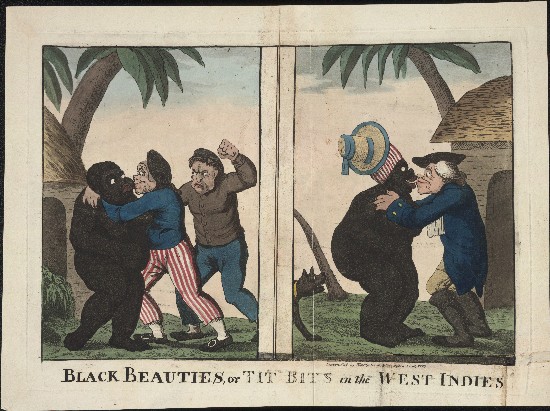
For instance, the far left panel of Black beauties, or, Tit bits in the West Indies, published by William Holland, illustrates a white man assaulting a naked black woman with a kiss.(41) Another man, perhaps an unwanted suitor, shakes his fist at the pair. The unclothed woman gasps in surprise at her suitor’s approaching lips, with her ample bare breasts on display to the viewers. Not included in the copy in the Lewis Walpole Library, but present in the John Carter Brown Library’s edition of the print is a middle plate, featuring a reclining woman in an almost pastoral pose.
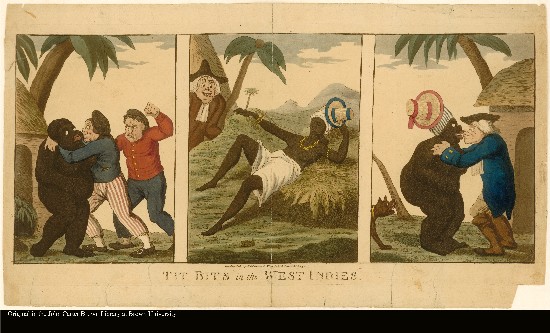
Featuring a more traditionally sexualized figure, with conventional European-styled body posed in a tropical scene, its subject is bare breasted, with her bottom half wrapped in white cloth, while she sleepily reclines in a position that invites the viewer to imagine what other situations this bodily placement might accommodate. Unbeknownst to the slumbering woman, a man dressed in clerical garments stares at her from the side of the image. His eyebrows arch in excitement, while his tongue partially protrudes from his grimaced mouth, and his cheeks flush, signaling a moment of delight. His pose suggests that behind this frame, he is pleasuring himself while watching her sleeping. In the far right plate, a similarly rendered woman as shown in the scene on the left, now dons a striped kerchief on her head, topped with a beribboned straw hat. Although still unclothed, she is depicted as seemingly enjoying the attentions of a more fashionably dressed gentleman in a wig, jaunty hat, and blue frock coat.(42) These women are portrayed as well fed, and although not always willing participants, a sense of pressing violence is relatively absent from these depictions. Replaced by humorous encounters, the viewer could be entertained without a moralizing undertone. Signaling the delights that the colonies could offer for a white man, that was unbridled access to an enslaved population, this print offers different scenic opportunities for voyeuristic metropolitan fantasies. Indeed, in all three scenes African women are sexually available to the white population, whether they are aware of it or not.
<12>Richard Newton’s What a Nice Bit!, presents an even more uncomfortable view of interracial relations in the West Indies. Like many of the satirical prints featuring the West Indies as their subject matter, this was also published by Holland.(43) Previous interpretations have read this print as a man being dismayed to find a black woman in his bed, connecting this print to another by William Hogarth, which illustrates the tale of John Highmore of the Drury Lane Theatre, who attempted to seduce a friend’s wife, only to find a black woman in her place in the bed the next morning.(44). While the story was well known amongst theatre and artistic circles, What a Nice Bit! does not appear to have more than a passing visual connection to Hogarth’s print.(45) Instead, in Newton’s depiction, the white man dressed in nightclothes is depicted as guiltily gazing at the sleeping black woman with the aid of his candlelight.
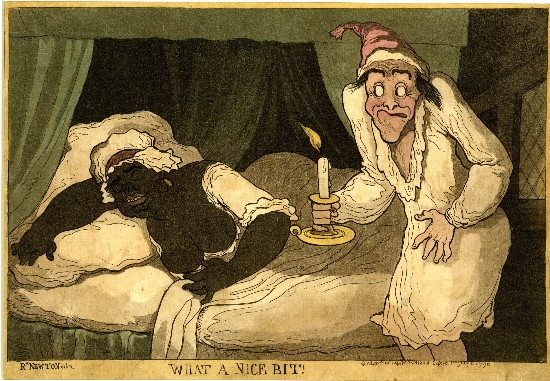
<13>The woman, wearing a nightcap and a nightgown—notably open in the front to show her bosom protruding onto the white sheets of her bed—apparently intrigues the sheepish man. The man’s left hand is deliberately placed against his body, insinuating, like the rising of his pointed nightcap, his bodily reaction to the scene before him. The viewer is left to wonder if this scene is pre- or post-coital, and whether the man looks guilty for actions he has committed, or those he is perhaps about to commit with the slumbering object of his affections. The many potential readings of the print therefore agree with Odumosu’s analysis of the layered but unsettling view of African women as symbolic of illicit desire, “in which she is at once seductive temptress and the figure of potential revulsion” (Odumosu 103).(46) Portraying black women as unclothed and ready to be ravished by all manner of white men, these prints, like the written accounts discussed above, unveiled the forbidden pleasures potentially awaiting the British male visitor in the sugar plantation islands. More specifically, Kriz posits that these images “render these ‘West Indianized’ black women in the form of bodies that are grotesque, even disgusting, and because of their hyper-sexualized animality, capable of inciting the most primitive form of desire in white men” (Kriz 107).(47)
<14>Notably, 1796, the year in which this print was issued, marked a decline in popular support for the abolitionist movement after the defeat of William Wilberforce’s abolition bill by the House of Commons in 1791.(48) The earlier fervor that had led to the initial success of the abolitionist campaign stalled in the wake of the French Revolutionary Wars and the Haitian Revolution. Distracted by the possibility of slave revolts spreading to the British holdings, as well as opportunities for imperial expansion in this period of instability, attention towards abolition waned. This print is accordingly significant for highlighting one of the arguments for the continuation of slavery raised during the abolition debates in Parliament, specifically the idea that the white population could not endure the strenuous work in the tropics like the Africans could. The potentiality of a mixed race population therefore posed a particular problem. Many individuals with connections to the West Indies, such as the famed planter William Beckford (1760-1844), argued that the “mulatto” population was unsuited for labor on the plantations.(49) Indeed, the fear that white men were indiscriminately promiscuous with enslaved black women in the West Indies was founded in truth, as most recently canvased by David Livesay in his work on mixed race children in Jamaica from 1733-1833.(50) This print must therefore be placed in a context in which the arguments for and against abolition were very much in the cultural consciousness of the British metropole, and in which both the sexualized black laboring body and the identity of the white plantation owner figured explicitly.
<15>Isaac Cruishank’s print, The Morning Surprise (1807, fig. 4), shows satirist’s continued interest in both the West Indies and the sexual mores of its inhabitants well into the nineteenth-century. Like the woman from What a Nice Bit!, its subject wears a nightdress open in the front, along with a nightcap tied with a blue bow, while her appearance in the bed is clearly intended to inspire mirth in the viewer of the scene. The caption below the title reads ‘“Why who the Devil have we got here!! - It is only me Massa.”’ Dating from around 1807, the print’s publication also coincides with a number of important events in British history. Rather than simply amusing British audiences, this print by Cruikshank reminds the viewer of the ongoing sexual alliances that threatened both white and black family structures in the sugar plantation islands at this time, which was particularly important after the passage of the Slave Trade Act of 1807. Following the abolition of the African slave trade, the need for a naturally reproducing black population was ever more crucial for the survival of colonial enterprises in the West Indies. As a result of such liaisons, metropolitan audiences both fetishized black women’s bodies, while simultaneously criticizing white men for their indulgences.(51) Therefore by taking enslaved women as sexual companions, and compelling them to a life of concubinage, planters were selfishly contributing to the failure of a self-reproducing slave population.
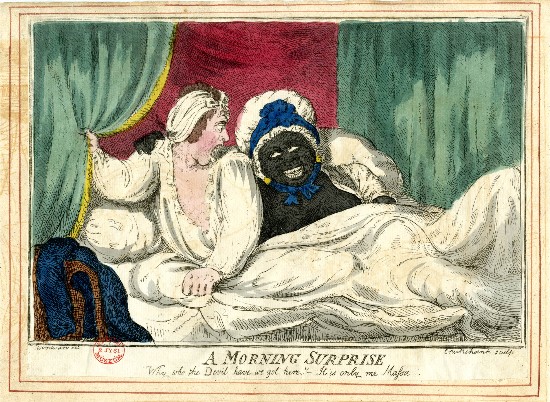
Johnny Newcome Visualised
<16>Tellingly, it is around this date that Abraham James’s caricatures featuring the character of Johnny Newcome—the young uninitiated man who relocates to the West Indies to gain fame and fortune—were first published, often employing visual and rhetorical devices from these earlier works. Similar to Hogarth’s series of ‘modern moral progresses’, such as The Rake’s Progress (1732-33), The Harlot’s Progress (1731), and Marriage-à-la-Mode (1743-45), the Johnny Newcome prints comprised small vignettes that, when read sequentially, came together to tell a complete story of a young man newly arrived to the sugar plantation islands of the Caribbean.(52)
<17>The first print published from this series, Johnny Newcome in Love in the West Indies, produced by the designation “J.F.” depicts the character of Johnny Newcome in six scenes in which the viewer voyeuristically watches Newcome court and seduce a woman of African descent. Its first vignette depicts Newcome enamored by a black woman standing in a field, whose pendulous breasts and large smile capture Newcome’s heart. The second prospect depicts the object of his desire, who is identified as “Mimbo Wampo” and is shown massaging his feet. Passionate for this “sable Venus,” the third image depicts Newcome consulting an enslaved man on how to best attract her. In the fourth image, Newcome is kneeling and pledging his affections to ‘Mimbo’ as “Queen” of his “harem.” By the fifth image, Newcome is surrounded by women and infants, who are likely his own progeny, while he takes his leave of “Frying Pan Island,” to voyage back to his “native land.”(53) As is usual in such prints, the image both satirizes creole men’s infamous sexual debauchery, while also revealing greater issues and fears regarding this imperial experiment, as is made clear in the final image of the print. Including nine of Newcome’s offspring and their ranging skin tones, hair styles, and fashion choices, the children are named on the bottom of the print. Most tellingly, one of his sons is designated “Hector Sammy Newcome,” “a child of great spirit can already damnme Liberty and Equality and promise fair to be the Toussaint of his Country,” thereby deliberately invoking the Haitian Revolution, which took place from 1791-1804.
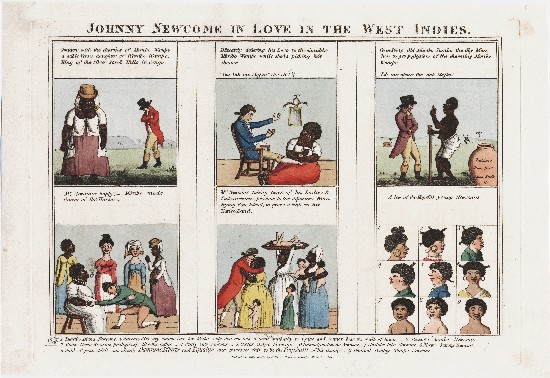
<18>In claiming that this mixed race “Newcome” might be the
“Toussaint” of his country, the print hearkens back to the beginning
of the Haitian Revolution, when in 1790, Vincent Ogé, a man of mixed
race descent, began a revolt in Saint Domingue, which many scholars
mark as a prelude to the larger Revolution.(54)
In 1808, the French and British empires were still reeling over the
loss of Saint Domingue. Toussaint, while both feared and admired in
British circles was long dead, but the new country of Haiti posed a
specter of possibility of what could occur in a slave colony like
Jamaica.(55) The print’s reference to a new
Toussaint in the figure of this mixed-race Newcome, therefore hints
towards this haunting potentiality, highlighting, once again, the
dangers of such interracial assignations. By explicitly referencing
this important figure, this print connects British colonial society
with larger Atlantic world events.
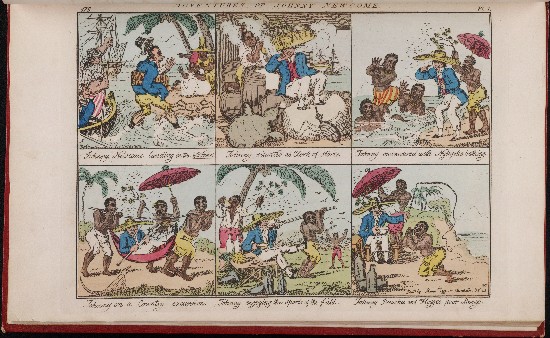
<19>The two plates comprising William Elmes’ more detailed narrative Adventures of Johnny Newcome (1812, fig. 6) share some similarities with Johnny Newcome in Love in the West Indies, although it develops the story in more detail.(56) In the first scene the character is seen disembarking from his small vessel, a proper ingénue. Charmed by two women of African descent on the shore, his hat flies off of his head in a delighted response to the scene on the beach. Like the Newcome from the previous print, this version of the popular figure can hardly contain his excitement for the delights of the flesh present offered by his new environment. The women point and wave at the stranger, while Newcome sheepishly gestures in return. Newcome is clearly susceptible to the attractions of these women, with the insinuation being that he will indulge in the pleasures that the West Indies presented to white men. The next scene finds Newcome reclining on cargo as a clerk. Although the position of clerk was at the bottom of the social ladder for white men in the West Indies, progression, perhaps first to the position of overseer, and then to the prestigious attainment of “planter,” was a goal for many. In the third scene, a monocle-wearing Newcome gawks at a group of half-dressed black women, identified in the print as “nymphs,” who are bathing as if for his own entertainment. Fully enamored, Newcome seems destined to succumb to the temptations of the island. A man stands next to Newcome, shielding him with a fetching umbrella, and shooing away deadly mosquitos from Newcome’s susceptible skin, although this metaphor of protection from contagion clearly also relates to the “nymphs” whom he surveys.(57) This inclusion might also indicate that Newcome has risen in the plantation society by purchasing an enslaved man for himself, although he has yet to full deteriorate into to the dissolute stereotype of the planter.
<20>By the fourth scene, Newcome’s decline seems imminent, displaying the lethargy and indolence noted by contemporary travel writers, and popularized in novelists.(58) This behavior was specifically linked to the West Indies’ comparatively warm climate.(59) William Falconer’s 1781 Remarks on the Influence of Climate posited that “although the enthusiasm of love be most powerful in such climates, yet this passion is in them far from being of a refined nature in point of sentiment” (Falconer 6-7).(60) Like the overconsumption of food and alcoholic beverages that they were also subject to while living in the island environment, white creole men in the West Indies were accordingly seen as living without sexual restraint.(61) As demonstrated in numerous visual and literary representations, these men were portrayed as unable to escape the negative effects of the sultry climate on their behavior and sexual conduct in this new environment.
<21> Plantation owner, politician, and writer, Bryan Edwards (1743-1800), also remarked in his The History Civil and Commercial, of the British Colonies in the West Indies (1793) on plantation culture and its effects on the creole populace, recording that the “effects of the heat on the body are sufficiently visible, making them not so timid as indolent” (Edwards 16).(62) This indolence was apparently due to their dependence on enslaved men and women for even the most menial of labors, leaving them entirely lacking the desire to perform tasks that could be accomplished by another.(63) The plantation system and the reliance on slavery seemed to render the planter class idle.
<22>Illustrating this, Elmes’s print shows Newcome on a “country excursion” to go hunting. Lacking the desire to walk on his own, he is carried in a hammock-like sedan through the sultry landscape. Too lazy to fan the mosquitos away, a dutiful attendant keeps these tropical menaces at bay. Once at his destination, Newcome enjoys a picnic of pineapple and sangaree, a popular wine punch. So unstimulated that he cannot even hold his own rifle, Newcome is propped by a slave while he takes aim at his prey. In the background, another slave attempts to stir up the birds into flight in order to give Newcome an easy target, all the while, another slave samples the fortified beverage behind his distracted master. Perhaps from being caught sampling this forbidden treat, the final scene portrays Newcome both preaching and flogging a slave, the typically-named Mungo. With bottles of sangaree nearby, a smoking and serene Newcome metes out judgment to the supplicant slave. As when he was hunting in the earlier scene, the nonchalant Newcome cannot muster the energy to perform his task while standing, so sits under the shaded hat and umbrella to punish Mungo, once again correlating with the typical indolence of creole men as noted by commentators, as well as the fears of the effects of slavery on British masculine sensibility.
<23>This set of images therefore presents a rather somber picture of the effects of plantation life on the British masculinity. Throughout its sequential plates the print’s titular character indulges in relations with the women on the island, before showing a lack of energy to perform even simple tasks like walking and shooting. Furthermore, he lacks the sensibility so prized by British novelists and writers in the late-eighteenth century.(64) By carelessly flogging the repentant slave, Newcome does not act as the ‘man of feeling’ ought, but is instead shown to be indulgently lazy with combined with flashes of violence.(65) Visualizing undesirable characteristics outlined in the contemporary textual materials cited above, these satirical prints found a receptive audience in Britain, for whom this depiction of improper masculinity would have particularly resonated.
<24>The second print in the Adventures of Johnny Newcome series (1803, fig. 7), continues the escapades of our titular hero, with this set of images invoking a Hogarthian examination of mercenary marriages. In this continuation of Elmes’s study of life in the Caribbean, the artist depicts the now initiated Newcome at a ball. With rosy cheeks from either the heat or the overconsumption of alcohol, and a large straw brimmed hat, he stares in wonder at the scene in front of him. One of the few white people in attendance, Newcome watches in delight as the “happy” inhabitants of the island engage in a scene of mirth and revelry, as exemplified by the fiddler, suspended above the crowd, and watching over a colorfully-clad group of dancers. This “merry” scene, depicts a panoramic view of a Jamaican “carnival,” a day that allowed the inversion of the traditional social order, such as the imitation of the planter class by enslaved individuals, and which coincided with the end of the harvest.(66)
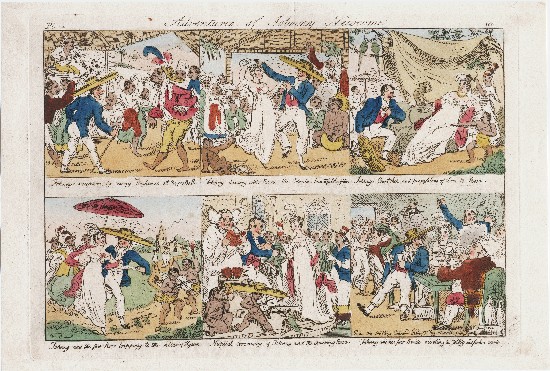
<25>In the second plate, Newcome dances with the beautiful, and conveniently rich heiress, “Rosa,” who is identified as a planter’s “beautiful daughter.” Although shown experimenting sexually with the black women on the island in the previous images, this does not stop Newcome from seeking an advantageous marriage with a white woman. The next scene quickly escalates to depict Newcome courting Rosa and professing his love for the wealthy heiress. In plate four, Newcome and Rosa are seen visiting the “Altar of Hymen,” a reference to both the Greek god of marriage, and to Newcome’s consequently elevated place within high society of the plantocracy in Jamaica. The final scene shows “Johnny and his bride reveling in jollility and festive mirth.” Sprawled with the signs of overconsumption about him, the paunchy man across from Newcome represents his future self as overweight and indulgent. Surrounded by merry makers and empty bottles of sangaree, we can only hope for a better future for Newcome and Rosa than the victims of mercenary marriage in Hogarth’s earlier series.
<26>As with the previous images discussed, the print is characterised by typical metropolitan fears over the colonial world, particularly around interracial socializing and sexuality. Audiences might, for example, question the racial heritage of the Newcome’s bride. Although identified a “planter’s daughter,” Rosa’s mother is not depicted within the image. As noted above, fears around interracial marriages and their resulting progeny preoccupied critics of the British imperial holdings during this period, with both Newcome’s early sexual endeavors on the island and Rosa’s mysterious origins highlighting such concerns.(67) Finally, the series echoes the fear that enterprising fortune seekers might travel to the West Indies to find eligible heiresses.(68) Susceptible to the charms of these resourceful Casanovas, these young women could potentially lose their inheritance through the foolish speculation, gambling, and schemes of their husbands.
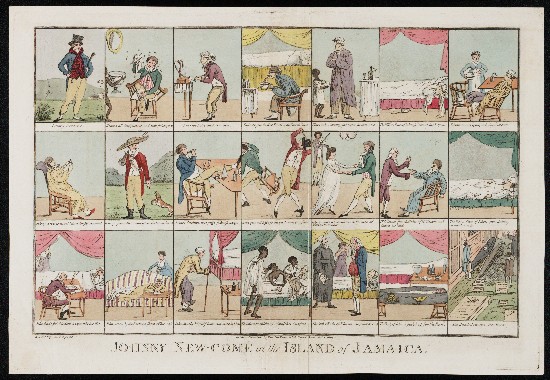

<27>The last print under discussion, James’s Johnny Newcome in the Island of Jamaica, (1803, fig. 8) represents a more somber glimpse of life in the West Indies. Twenty-one images make up the print, which once again focuses on the life and travails of transplanting to the tropics. In the first image, Newcome appears dapper and ready for life in the West Indies. By the second scene, he is already suffering from the island pests, and calls for more intoxicating beverages to cope with these winged menaces.(69) The third and fourth plate find Newcome dealing with island sicknesses, and experiencing both fevers and trembles, “fruits of the Torrid Zone.” By the fifth scene, Newcome is shown as regretting relocating to Jamaica, no doubt compounded by his vomiting in the sixth image. Things are looking better for Newcome in the final image, however, where he is shown to be “domesticating.”
<28>The second line of images (fig. 10) begins with Newcome convalescing and with him believing himself to be a “seasoned” resident of the island.(70) This accords with the contemporary idea that those who survived the first bouts of illness could be more successfully to endure their time on the islands.(71) Now hardened, Newcome indulges in hunting, smoking, and fortified beverages, and dances with an attractive and fashionably-attired creole. But not all is well for Newcome, who has not fully recovered from the sickness. The last image on this second line is captioned “The Yellow Claw of Febris Give Newcome a Mortal Nip,” indicating that he is suffering from yet another tropical ailment, most likely malaria.(72) Calling for an attorney (fig. 11), he settles his affairs, and writes to his loved ones in England. While rallying briefly, he eventually succumbs to illness, becoming delirious. A priest arrives, and the next image finds Newcome in a casket. The final scene depicts a cemetery, which is Newcome’s final resting place.


<29>The series, which harkens back to previous scenes of Hogarthian tragedy, shows that mortality was always present in the West Indies, whether due to tropical disease, natural catastrophe or slave rebellion. Although Newcome arrived in Jamaica with hopes of social and monetary success, he, like many real would-be planters, only found disease, homesickness, moral degradation, and death; with the prints compellingly blurring satirical representation with the realities of island life.
Conclusions
<30>Satirical prints, like those by James and Elmes, crafted compelling sequences that visualized anxieties towards the colonial efforts in the sugar plantation islands throughout the late eighteenth and early nineteenth centuries. While the British political elite debated the morality and merits of the African Slave Trade in Parliament, these prints provided a way for a larger British audience to view the West Indies and engage with the empire from afar. Although providing wealth for the planter class and Britain more broadly, by the early nineteenth century, criticism towards the methods used to extract sugar from the West Indies proliferated in the metropole, with popular boycotts against this imperial product.(73) Though satirical in nature, important political themes emerge in these prints, with their depictions of the failure of white planters to create a stable home and economic system illuminating contemporaneous debates concerning the sexual morality present in the sugar plantation islands; slave reproduction in the era of abolition; and the perceived problems posed by a growing mixed race population.
<31>Through ridiculing white male inhabitants who attempted to recreate metropolitan lives in this frontier of empire, extant caricatures focusing on the British holdings in the Caribbean contain underlying concerns regarding the effects of the tropical landscape on British residents. These focused upon the islands’ climates, residents’ sexual immorality with enslaved women, the potential seduction of heiresses, social climbing, and the laziness of the planter class. Furthermore anti-slavery activists were successfully employing the tropes from these varied sources to bolster their noble cause.(74) Ranging from comical to macabre, the Johnny Newcome prints not only offer a glimpse of the metropolitan perceptions of the West Indies, but also of imperial masculinity itself, highlighting how the latter was crafted and developed through its representation within the genre of the satirical print.(75>)
